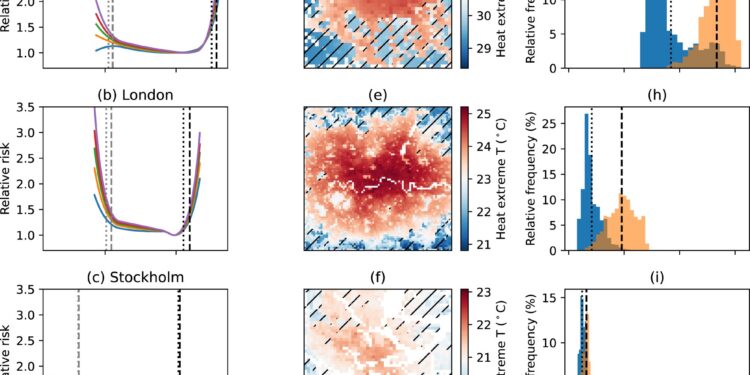Examples of cities. a–c Exposure-response relationships grouped by age, mean temperature d–f during the 2% hottest days between 2015 and 2017, and g–i histograms of mean temperature-related mortality estimates over the 2 % of hottest days shown separately for urban and rural areas. zones for a, d, g Milan, b, e, h London and c, f, i Stockholm. The black/gray vertical dashed lines in a–c, g–i represent the urban average of the hottest/coldest 2% of days; vertical dotted lines represent the rural average. Hatching indicates rural areas in d–f, where areas excluded from the analysis (water bodies and areas with a difference in elevation greater than 100 m from the population-weighted average) are shown in white. Credit: Natural communications (2023). DOI: 10.1038/s41467-023-43135-z
A new study led by EPFL has produced the first estimate of the cost of the impact of urban heat islands on human health. The study covered 85 European cities for three full years and therefore also took into account the protection offered by heat islands in winter, an aspect little studied until now.
The results are published in the journal Natural communications.
The heat islands found in many European cities have a clear impact on the risk of human mortality, comparable to air pollution or, in cost terms, to the price paid by city dwellers for public transport . At least that’s what the study reveals, which estimates the average cost at €192 (around $210) for heat-related effects per adult resident per year.
This work is the first to quantify the economic consequences of a problem common to many urban areas around the world but which scientists still have difficulty understanding in all its complexity. To arrive at such simple and tangible numbers, the research team combined data and methods from a wide range of disciplines, including urban climatology, epidemiology, economics, statistics and mathematical modeling .
“Our research shows that heat islands are not just caused by people being too hot in summer,” says Gabriele Manoli, the study’s corresponding author. “They also have significant adverse effects on human health, leading for example to increased cardiovascular and respiratory risks and reducing overall life expectancy.”
Manoli is a tenure track assistant professor at EPFL and head of the Urban and Environmental Systems Laboratory at EPFL’s School of Architecture, Civil and Environmental Engineering (ENAC).
Potentially deadly, but also protective
The threats posed by urban heat are obviously not the same depending on whether you are in Helsinki, Geneva or Madrid, and Spaniards are clearly more accustomed to higher temperatures than those living in Finland. This study is the first to examine the effects of urban heat islands in different cities and seasons, compiling large amounts of data and simulations to assess both summer heat island damage and protection that they offer during cold spells in summer. winter.
For each city, scientists estimated temperature risks and translated them into health costs, taking into account both summer and winter effects as well as the net annual effect. Little research has been conducted to date on the economic impact of urban heat risk and the role that heat islands play in winter. This study estimates the average “savings” per adult inhabitant per year on the effects of cold at €314. Scientists found that, for example, Geneva’s urban heat island can cause four additional heat-related deaths per 100,000 residents per year, but can prevent 3.4 cold-related deaths.
Make informed decisions
With this study, Manoli and his colleagues, based in the UK, US and Singapore, hope their research will shed light on these important questions and inform future climate change planning and mitigation strategies. Manoli explains that their interdisciplinary approach can help urban decision-makers assess heat risks and juggle the many factors associated with urban heat islands. “The aim is to make these areas less dangerous during the summer months without compromising the protection they can offer in winter,” he explains.
“Our study shows that the impact of heat islands varies significantly between cities and seasons. In the future, policymakers will be able to use this concrete information in their decision-making.”
The full research paper contains tables listing the 85 cities included in the study, along with their heat island-induced mortality, years of life lost and estimated economic impacts. Again taking the example of Geneva, the net cost of mortality due to heat islands was €20.7 per adult resident per year (€155 due to the heat risk and – €134 due to the cold). , while in Trieste it was €184.4 (€547 and –€363 respectively due to the risk of heat and cold).
Negative net cost
Some European cities even had a negative net cost, due to the protection provided by heat islands during prolonged cold seasons. In Helsinki, for example, a net saving of €113.9 was achieved. However, scientists stress that such figures should not lead city planners to rest on the dangers posed by extreme heat, as its effects are very harmful in summer and are likely to get worse in the future.
Manoli intends to take this research further by addressing the limits of this first study. For example, he plans to refine these initial cost estimates by studying the relationship between heat islands, social inequalities and modes of transportation.
More information:
Wan Ting Katty Huang et al, Economic assessment of temperature-related mortality attributed to urban heat islands in European cities, Natural communications (2023). DOI: 10.1038/s41467-023-43135-z
Provided by the Ecole Polytechnique Fédérale de Lausanne
Quote: Urban heat islands have a cost for health, reveals a study (January 23, 2024) retrieved on January 23, 2024 from
This document is subject to copyright. Apart from fair use for private study or research purposes, no part may be reproduced without written permission. The content is provided for information only.



